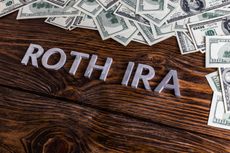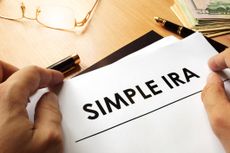The Price of Leaving 401(k) Money Behind
Many baby boomers have worked for at least six employers during their career. Leaving 401(k) funds dormant can be costly.

The average baby boomer has worked for six different employers over the course of their career, not counting jobs before age 24, according to the Bureau of Labor Statistics. That's a lot of opportunities for retirement savings to be overlooked or lost. "People tend to forget that they have old 401(k) plans from past jobs," says Amie Agamata, a certified financial planner based in San Diego and president-elect of NexGen, the Financial Planning Association's group for new and aspiring financial planners.
In retirement, a forgotten 401(k) account can cost you both time and money. One of Agamata's clients can't access her 401(k) account from a company that has now gone out of business and has to search state abandoned property records in hopes of finding the missing funds.
Even if you've kept track of all your accounts, having too many of them complicates retirement planning unnecessarily. It means more companies to contact if you move or want to change beneficiaries, and more rules for you to follow -- or risk hefty penalties for getting any of them wrong. This is particularly important once you turn 72 and must begin taking required minimum distributions. A missed RMD is hit with a 50% penalty on the amount that should have been withdrawn.

Sign up for Kiplinger’s Free E-Newsletters
Profit and prosper with the best of expert advice on investing, taxes, retirement, personal finance and more - straight to your e-mail.
Profit and prosper with the best of expert advice - straight to your e-mail.
By consolidating accounts as retirement nears, you'll also be able to organize and manage your investments better, with the potential to save on fees and taxes, according to financial planners. "Simplification is the advantage of consolidating retirement accounts," says Zaneilia Harris, a certified financial planner based in Upper Marlboro, Md., and author of Finance 'n Stilettos (Dog Ear Publishing, $18). "Knowing how much you have can help you manage your portfolio and evaluate your individual holdings so they align with your current financial goals."
The Pinch to Your Portfolio
Leaving 401(k) savings with a former employer can also take a bigger bite out of your investment portfolio. Although a former employer must let you keep the money in the 401(k) if the balance exceeds $5,000, the company can force accounts under that limit into a rollover IRA invested so conservatively that annual fees can quickly erode the value. A Government Accountability Office study of forced-transfer IRAs found that annual fees combined with low investment returns could exhaust all the assets in an IRA worth $1,000 in just nine years.
Even an account balance greater than $5,000 has the potential to cost you more if you leave the money behind in a former employer's plan. A 401(k) offers limited investment choices, whereas with an IRA, "typically, you're going to have more investment options," says Henry Hoang, a certified financial planner and founder of Bright Wealth Advisors in Irvine, Calif. "More often than not you're going to have an opportunity to lower fees."
That's because a typical retirement savings plan from an employer layers additional management fees on top of those charged by mutual funds. Hoang estimates that a typical 401(k) plan charges expense ratios of 1% to 1.5% compared with mutual funds that often have fees of about 0.5%. And that's assuming you understand the plan's fees well enough to compare them because the costs aren't always clear. A different GAO report found that 45% of plan participants couldn't determine the cost of their investment fee based on plan disclosures, and 41% incorrectly believed they didn't pay fees.
By contrast, if you open an IRA with a brokerage or mutual fund company, you likely will only pay the fees from the specific investments you choose. "It's gotten really competitive, and it's worked in the favor of retail investors," says Hoang.
One downside of consolidating accounts is that you can lose access to commission-free trading or a specific investment in your 401(k) that only institutions can purchase. For instance, it would be hard to replicate a stable value fund held inside your 401(k) with new investments in an IRA, says Adam Wojtkowski, a certified financial planner in the Boston area. A stable value fund is a low-risk investment that provides higher yields by investing in short-term bonds as well as insurance contracts that protect against a drop in rates. These funds are only available in 401(k) plans. "You have to weigh the mathematics of, am I really that much better off with this special fund that I have access to, versus realistically, what am I going to get the most value out of?" Wojtkowski says. "Am I going to have a clearer picture of my overall financial standing if I could just see everything in one place?"
Special Exceptions
You may also want to postpone consolidating accounts if you're in your 50s and your 401(k) plan allows partial withdrawals that you might want to tap. The pandemic and Great Resignation are prompting many people to retire early, so many in fact that a new term has been coined, the Gray Resignation.
If you fall under this category, pay special attention to what you would lose by consolidating accounts. People between ages 55 and 59½ may be eligible for a special exception to the 10% early withdrawal penalty on plan distributions before age 59½. If you retire from a job during those years, you may take a tax-free distribution from the 401(k) of that employer only. "If I consolidate, if I roll it over to an IRA, I've now foregone that ability," Wojtkowski notes. If your plan allows partial withdrawals, you can even take a tax-free distribution in only the amount that you expect to need for living expenses between now and age 59½.
Another way to take distributions before the standard age is through the 72(t) rule, which allows you to take equal periodic payments between now and age 59½ without the 10% penalty, as long as that period is at least five years. Hire a financial professional to set this up, because if you miscalculate, the IRS can levy a penalty not just on the year that you messed up, but on all years, he says.
Where Simplification Counts Most
Once you're retired, you can be more strategic about taking required minimum distributions if you roll over money from qualified retirement accounts into an IRA. This is particularly important when required minimum distributions kick in at age 72. RMDs, which both IRAs and 401(k)s have, are based on your life expectancy and the value of a retirement savings account, but the rules for satisfying the distributions are different depending on the type of account it is. If it's a 401(k) or another employer's retirement savings plan, distributions must be taken from each account separately. So, for example, if you have three 401(k)s, you must take an RMD from each one.
IRAs, on the other hand, offer more flexibility. If you have multiple IRAs, you can satisfy the RMDs for all IRAs by withdrawing money from one account. "If I'm consolidated, I have more flexibility about when and where I take required minimum distributions," says Wojtkowski. For example, if stocks are falling, you can avoid realizing those losses by taking your RMD from an IRA that holds bond investments or money market funds instead.
Rollover Rules That You Should Never Ignore
Whenever you're consolidating qualified retirement savings plans or IRAs, check out the Internal Revenue Service's rollover chart to be sure the move you want to make is allowed. If possible, request a direct rollover from one account to another so that the money bypasses you. Otherwise, you risk creating a taxable event if the check is made out and sent to you, with the money subject to 20% withholding and possibly a 10% penalty if the withdrawal is considered an early distribution. In that situation, the retirement plan withholds 20% of the withdrawn sum, and you would have up to 60 days to roll over the full amount, making up the 20% shortfall from other funds to avoid the penalty.
If you're rolling over the money into another employer's plan, take the time to read your plan documents carefully. The rules for rollovers will vary.
Depending on the circumstances, some accounts can't be consolidated. For example, you can't combine your IRA with your spouse's while both of you are alive. Nor can you merge inherited IRAs that you received from two different people.
Get Kiplinger Today newsletter — free
Profit and prosper with the best of Kiplinger's advice on investing, taxes, retirement, personal finance and much more. Delivered daily. Enter your email in the box and click Sign Me Up.
Katherine Reynolds Lewis is an award-winning journalist, speaker and author of The Good News About Bad Behavior: Why Kids Are Less Disciplined Than Ever – And What to Do About It. Her work has appeared in The Atlantic, Fortune, Medium, Mother Jones, The New York Times, Parents, Slate, USA Today, The Washington Post and Working Mother, among others. She's been an EWA Education Reporting Fellow, Fund for Investigative Journalism fellow and Logan Nonfiction Fellow at the Carey Institute for Global Good. Residencies include the Virginia Center for the Creative Arts and Ragdale. A Harvard physics graduate, Katherine previously worked as a national correspondent for Newhouse and Bloomberg News, covering everything from financial and media policy to the White House.
-
 Here's How To Get Organized And Work For Yourself
Here's How To Get Organized And Work For YourselfWhether you’re looking for a side gig or planning to start your own business, it has never been easier to strike out on your own. Here is our guide to navigating working for yourself.
By Laura Petrecca Published
-
 How to Manage Risk With Diversification
How to Manage Risk With Diversification"Don't put all your eggs in one basket" means different things to different investors. Here's how to manage your risk with portfolio diversification.
By Charles Lewis Sizemore, CFA Published
-
 457 Plan Contribution Limits for 2025
457 Plan Contribution Limits for 2025Retirement plans There are higher 457 plan contribution limits for state and local government workers in 2025 than in 2024.
By Kathryn Pomroy Last updated
-
 What Does Medicare Not Cover? Seven Things You Should Know
What Does Medicare Not Cover? Seven Things You Should KnowHealthy Living on a Budget Medicare Part A and Part B leave gaps in your healthcare coverage. But Medicare Advantage has problems, too.
By Donna LeValley Last updated
-
 13 Smart Estate Planning Moves
13 Smart Estate Planning Movesretirement Follow this estate planning checklist for you (and your heirs) to hold on to more of your hard-earned money.
By Janet Kidd Stewart Last updated
-
 Medicare Basics: 11 Things You Need to Know
Medicare Basics: 11 Things You Need to KnowMedicare There's Medicare Part A, Part B, Part D, Medigap plans, Medicare Advantage plans and so on. We sort out the confusion about signing up for Medicare — and much more.
By Catherine Siskos Last updated
-
 The Seven Worst Assets to Leave Your Kids or Grandkids
The Seven Worst Assets to Leave Your Kids or Grandkidsinheritance Leaving these assets to your loved ones may be more trouble than it’s worth. Here's how to avoid adding to their grief after you're gone.
By David Rodeck Last updated
-
 SEP IRA Contribution Limits for 2024 and 2025
SEP IRA Contribution Limits for 2024 and 2025SEP IRA A good option for small business owners, SEP IRAs allow individual annual contributions of as much as $69,000 in 2024 and $70,000 in 2025..
By Jackie Stewart Last updated
-
 Roth IRA Contribution Limits for 2024 and 2025
Roth IRA Contribution Limits for 2024 and 2025Roth IRAs Roth IRA contribution limits have gone up. Here's what you need to know.
By Jackie Stewart Last updated
-
 SIMPLE IRA Contribution Limits for 2024 and 2025
SIMPLE IRA Contribution Limits for 2024 and 2025simple IRA The SIMPLE IRA contribution limit increased by $500 for 2025. Workers at small businesses can contribute up to $16,500 or $20,000 if 50 or over and $21,750 if 60-63.
By Jackie Stewart Last updated